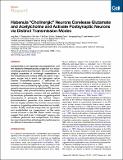| dc.contributor.author | Ren, Jing | |
| dc.contributor.author | Qin, Chang | |
| dc.contributor.author | Hu, Fei | |
| dc.contributor.author | Tan, Jie | |
| dc.contributor.author | Qiu, Li | |
| dc.contributor.author | Zhao, Shengli | |
| dc.contributor.author | Feng, Guoping | |
| dc.contributor.author | Luo, Minmin | |
| dc.date.accessioned | 2014-12-10T19:14:40Z | |
| dc.date.available | 2014-12-10T19:14:40Z | |
| dc.date.issued | 2011-02 | |
| dc.date.submitted | 2010-11 | |
| dc.identifier.issn | 08966273 | |
| dc.identifier.issn | 1097-4199 | |
| dc.identifier.uri | http://hdl.handle.net/1721.1/92260 | |
| dc.description.abstract | Acetylcholine is an important neurotransmitter, and the habenulo-interpeduncular projection is a major cholinergic pathway in the brain. To study the physiological properties of cholinergic transmission in the interpeduncular nucleus (IPN), we used a transgenic mouse line in which the light-gated cation channel ChannelRhodopsin-2 is selectively expressed in cholinergic neurons. Cholinergic axonal terminals were activated by light pulses, and postsynaptic responses were recorded from IPN neurons. Surprisingly, brief photostimulation produces fast excitatory postsynaptic currents that are mediated by ionotropic glutamate receptors, suggesting wired transmission of glutamate. By contrast, tetanic photostimulation generates slow inward currents that are largely mediated by nicotinic acetylcholine receptors, suggesting volume transmission of acetylcholine. Finally, vesicular transporters for glutamate and acetylcholine are coexpressed on the same axonal terminals in the IPN. These results strongly suggest that adult brain “cholinergic” neurons can corelease glutamate and acetylcholine, but these two neurotransmitters activate postsynaptic neurons via different transmission modes. | en_US |
| dc.language.iso | en_US | |
| dc.publisher | Elsevier | en_US |
| dc.relation.isversionof | http://dx.doi.org/10.1016/j.neuron.2010.12.038 | en_US |
| dc.rights | Article is made available in accordance with the publisher's policy and may be subject to US copyright law. Please refer to the publisher's site for terms of use. | en_US |
| dc.source | Elsevier | en_US |
| dc.title | Habenula “Cholinergic” Neurons Corelease Glutamate and Acetylcholine and Activate Postsynaptic Neurons via Distinct Transmission Modes | en_US |
| dc.type | Article | en_US |
| dc.identifier.citation | Ren, Jing, Chang Qin, Fei Hu, Jie Tan, Li Qiu, Shengli Zhao, Guoping Feng, and Minmin Luo. “Habenula ‘Cholinergic’ Neurons Corelease Glutamate and Acetylcholine and Activate Postsynaptic Neurons via Distinct Transmission Modes.” Neuron 69, no. 3 (February 2011): 445–452. © 2011 Elsevier Inc. | en_US |
| dc.contributor.department | Massachusetts Institute of Technology. Department of Brain and Cognitive Sciences | en_US |
| dc.contributor.department | McGovern Institute for Brain Research at MIT | en_US |
| dc.contributor.mitauthor | Feng, Guoping | en_US |
| dc.relation.journal | Neuron | en_US |
| dc.eprint.version | Final published version | en_US |
| dc.type.uri | http://purl.org/eprint/type/JournalArticle | en_US |
| eprint.status | http://purl.org/eprint/status/PeerReviewed | en_US |
| dspace.orderedauthors | Ren, Jing; Qin, Chang; Hu, Fei; Tan, Jie; Qiu, Li; Zhao, Shengli; Feng, Guoping; Luo, Minmin | en_US |
| dc.identifier.orcid | https://orcid.org/0000-0002-8021-277X | |
| mit.license | PUBLISHER_POLICY | en_US |
| mit.metadata.status | Complete | |
